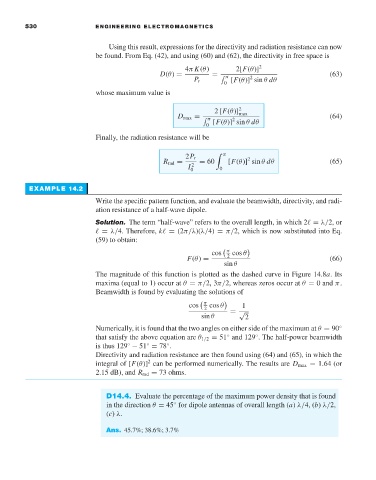Page 548 - Engineering Electromagnetics, 8th Edition
P. 548
530 ENGINEERING ELECTROMAGNETICS
Using this result, expressions for the directivity and radiation resistance can now
be found. From Eq. (42), and using (60) and (62), the directivity in free space is
4π K(θ) 2[F(θ)] 2
D(θ) = = π 2 (63)
P r [F(θ)] sin θ dθ
0
whose maximum value is
2[F(θ)] 2 max
D max = π 2 (64)
0 [F(θ)] sin θ dθ
Finally, the radiation resistance will be
π
2P r 2
R rad = = 60 [F(θ)] sin θ dθ (65)
I 0 2 0
EXAMPLE 14.2
Write the specific pattern function, and evaluate the beamwidth, directivity, and radi-
ation resistance of a half-wave dipole.
Solution. The term “half-wave” refers to the overall length, in which 2 = λ/2, or
= λ/4. Therefore, k = (2π/λ)(λ/4) = π/2, which is now substituted into Eq.
(59) to obtain:
cos π cos θ
F(θ) = 2 (66)
sin θ
The magnitude of this function is plotted as the dashed curve in Figure 14.8a. Its
maxima (equal to 1) occur at θ = π/2, 3π/2, whereas zeros occur at θ = 0 and π.
Beamwidth is found by evaluating the solutions of
cos π cos θ 1
2
= √
sin θ 2
Numerically, it is found that the two angles on either side of the maximum at θ = 90 ◦
that satisfy the above equation are θ 1/2 = 51 and 129 . The half-power beamwidth
◦
◦
is thus 129 − 51 = 78 .
◦
◦
◦
Directivity and radiation resistance are then found using (64) and (65), in which the
2
integral of [F(θ)] can be performed numerically. The results are D max = 1.64 (or
2.15 dB), and R rad = 73 ohms.
D14.4. Evaluate the percentage of the maximum power density that is found
in the direction θ = 45 for dipole antennas of overall length (a) λ/4, (b) λ/2,
◦
(c) λ.
Ans. 45.7%; 38.6%; 3.7%

